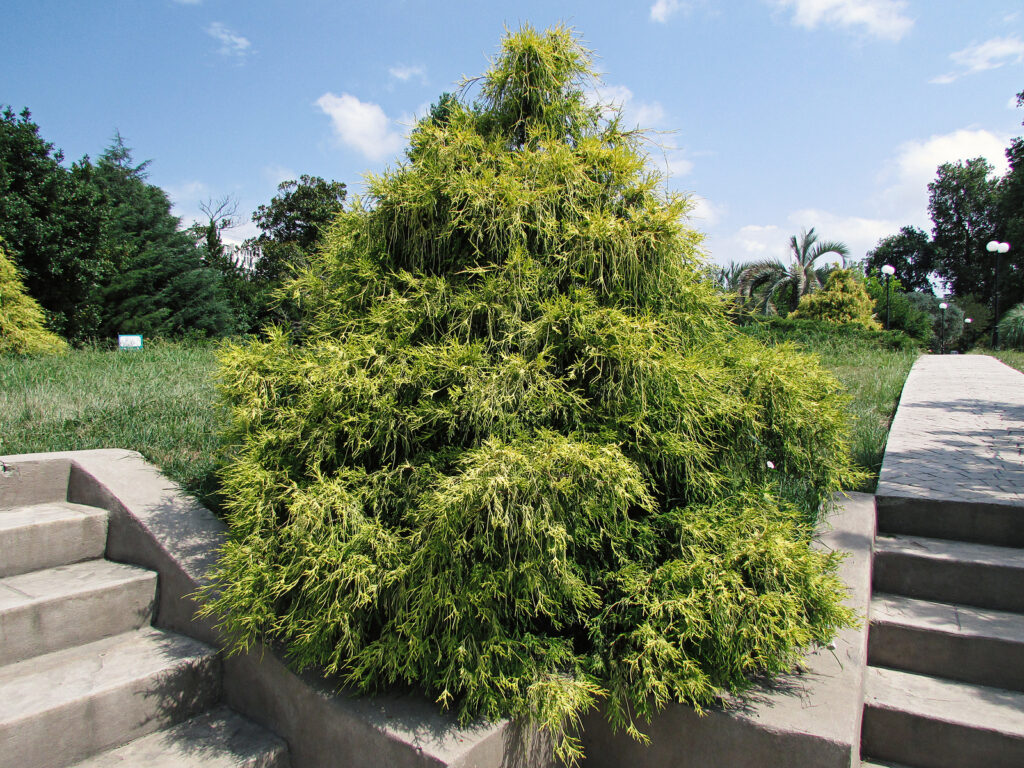False cypress, Chamaecyparis, is a slow-growing coniferous evergreen tree with sprays of scale-like blue-green foliage. Some false cypresses are small, just a couple of feet tall, others grow to 60 feet or more.
False cypresses are also known as white cedars. They are usually columnar in form, but compact forms are commonly used in gardens especially for hedges and foundation plantings.
False cypress does best in partly shaded locations with plenty of room between plants to ensure air circulation.
Grow false cypress in a well-drained loamy soil. Foliage may burn in winter wind and sun.

Get to know False Cypress
- Plant type: Evergreen coniferous tree or shrub
- Growing Zones and range: 5-8 depending on the variety
- Hardiness: False cypress grows best in cool, humid regions; some cultivars are more heat tolerant than others
- Height and spread: Many cultivars; some as short as 10 inches, others to 60 feet tall or more—see descriptions below
- Foliage: Foliage varies by variety from fernlike to fluffy
- Flowers: Inconspicuous flowers followed by brown cones in fall
- Bloom time: Spring
- Uses: Shrub border, foundation planting, rock gardens, specimen
- Botanical name: Chamaecyparis spp.
- Family: Cupressaceae
- Common name: False cypress, white cedar
- Origin: Forests in Taiwan, Japan, and North America
Where to plant False Cypress
- Grow false cypress in full sun.
- Plant false cypress in humus-rich, well-drained soil.
- Plant false cypress where it will be protected from the wind.
When to plant False Cypress
- Transplant container-grown or balled-and-burlapped plants in spring.
Planting and spacing False Cypress
- Space false cypress at distances that allow plants to reach full maturity.
How to water and feed False Cypress
- Keep the soil evenly moist
- Fertilize false cypress by mulching with aged compost around the plant and out to the dripline.
False Cypress care
- Prune false cypress to shape in spring.
- Mulch around false cypress to keep the soil evenly moist; use a layer of shredded bark mulch.
False Cypress common problems
- False cypress is susceptible to a fungal disease that attacks roots. Dig out and destroy diseased plants. Plant in moist but well-drained soil.
- Spider mites can attack false cypress in dry summers.
False Cypress propagation
- Take cuttings in fall.
False Cypress varieties to grow
- Hinoki False Cypress, Chamaecyparis obtusa: Zones 5-8; 40’-50’ tall, 10’-20’ wide; graceful and frond-like, broad-sweeping form; dark, velvety green scale-like foliage; best in cool, humid climates such as Pacific Northwest; ‘Nana’ grow to 3’ tall and wide, dark green and velvety; ‘Nana Gracilis’ grow to 10’; ‘Nana Lutea’ grow to 10 inches with yellow leaves; ‘Crippsii’ is pyramid growing to 15’, yellow foliage fades to dark green; ‘Filicoides’ has pendulous fernlike foliage, slow-growing to 10’.
- Japanese False Cypress, Swara False cypress, Chamaecyparis pisfera: Zones 5-8; 50’- 70’ tall, 10’- 20’ wide; several cultivars; dark to bright green foliage; adapted to Midwest conditions or Northeast and cool, humid climates; ‘Filifera’ has thread-leaf foliate to 10’; ‘Golden Map’ is rounded to 3’ and bright yellow; ‘Plumosa’ is soft and feathery; ‘Plumosa Aurea’ is golden yellow and feathery; ‘Plumosa Compacta’ grows to 3’; ‘Squarrosa’ has velvety blue foliage and grows to 15; ‘Boulevard’ is slow-growing, blue-green to 15’; ‘Squarrosa Pygmaea’ is mounded bluish to 3’.
- Lawson False cypress. Chamaecyparis lawsoniana: Zones 6-8; 40’- 60’ tall, 10’- 20’ wide, many cultivars are smaller; grown mainly in Pacific Northwest; soft, needle-like foliage, flattened sprays in vertical planes; yellow and blue to dark green foliage; best in cool, humid climates; ‘Alumnii’ is narrow to 13’ tall; ‘Nana’ is rounded and shrubby to 6’; ‘Golden Showers’ has pendulous bright yellow branches; ‘Oregon Blue’ is conical to 25’ tall.
- Nootka cypress, or Alaska cedar, Chamaecyparis nootkantensis, is blue or gray-green; ‘Pendula’ has a weeping form.















